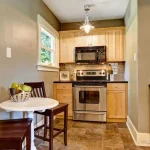An open concept kitchen is a modern layout design where the kitchen is integrated with adjoining living spaces, such as the dining room and living room, creating a seamless flow without the use of walls or partitions. This design promotes interaction and accessibility, making it a popular choice for contemporary homes.
Relevance and Popularity in Modern Homes
The popularity of open concept kitchens has surged in recent years due to their ability to make homes feel larger and more inviting. They cater to the modern lifestyle, where cooking, dining, and socializing often occur simultaneously. By eliminating barriers, open concept kitchens create a more inclusive environment, enhancing the home’s overall functionality and aesthetic appeal.

Benefits of an Open Concept Kitchen
- Enhanced Social Interaction: Open layouts allow for better interaction with family and guests while cooking.
- Improved Light Flow: The absence of walls allows natural light to penetrate deeper into the home, creating a brighter space.
- Versatility in Design: These kitchens can be customized to match various design preferences, from modern to rustic.
- Increased Home Value: Open concept designs are highly desirable in the real estate market, often leading to higher property values.
Historical Context
Evolution of Kitchen Design
The kitchen has transformed dramatically over the centuries. Historically, kitchens were separate, functional spaces meant solely for cooking and food preparation. Over time, as social dynamics and household structures evolved, the kitchen became a central gathering place, leading to the development of more open and inclusive layouts.
The Shift from Closed to Open Kitchens
The transition from closed kitchens to open layouts began in the mid-20th century, influenced by changing architectural styles and the desire for more multifunctional living spaces. This shift was driven by the need for better connectivity within the home, making it easier for family members to interact across different areas.
Influential Designers and Trends
Pioneers like Frank Lloyd Wright played a crucial role in popularizing open concept designs. Wright’s emphasis on organic architecture and seamless indoor-outdoor integration laid the foundation for modern open kitchens. Contemporary designers continue to innovate, blending functionality with aesthetics to create versatile and appealing kitchen spaces.
Key Principles

Space Planning
Effective space planning is essential for an open concept kitchen. It involves carefully considering the kitchen’s layout, ensuring ample room for cooking, dining, and socializing while maintaining a cohesive flow with adjacent areas.
Integration with Living Areas
An open concept kitchen should seamlessly blend with the living and dining spaces. This can be achieved through consistent design elements, such as matching flooring and complementary color schemes, creating a harmonious and unified look.
Balancing Functionality and Aesthetics
While aesthetics are important, functionality should not be compromised. An ideal open concept kitchen is both beautiful and practical, with well-placed appliances, sufficient storage, and efficient work zones.
Design Elements
Layout Options
- L-Shaped Kitchens: Offer flexibility and ample counter space, integrating well with dining areas.
- U-Shaped Kitchens: Provide maximum storage and workspace, ideal for larger open spaces.
- Galley Kitchens: Efficient for small spaces, with parallel counters creating a streamlined look.
Kitchen Islands and Peninsulas
Islands and peninsulas are central to open concept kitchens, providing additional workspace, storage, and seating. They also help define the kitchen area within the open layout.
Choosing the Right Materials
Selecting durable and aesthetically pleasing materials is crucial. Options like granite, marble, and high-quality wood can enhance the kitchen’s look while ensuring longevity.
Recommended: Split Level Kitchen Remodel: Ultimate Guide
Color Schemes and Themes
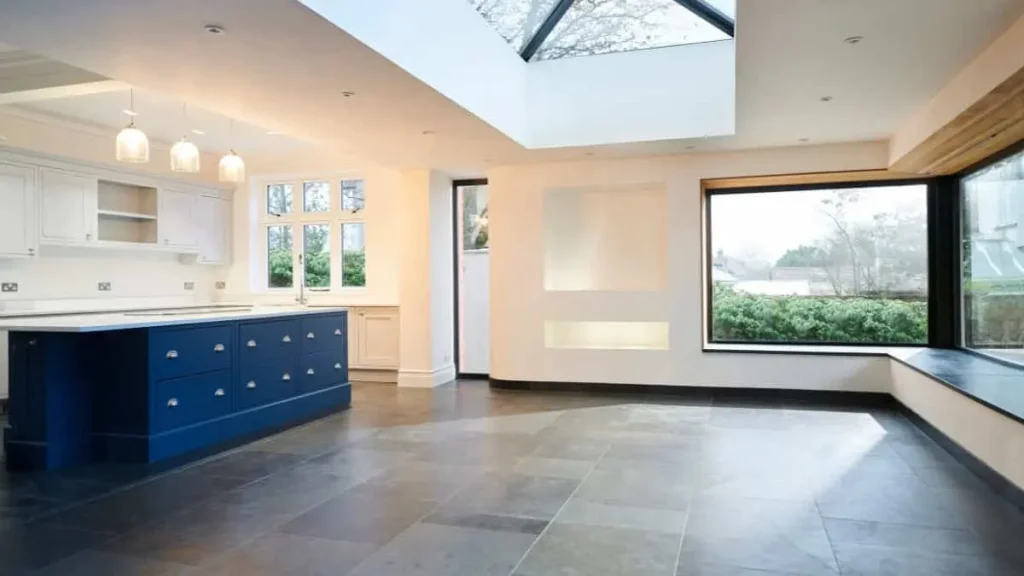
Neutral Palettes
Neutral colors, such as whites, grays, and beiges, create a timeless and sophisticated look, allowing for easy integration with various decor styles.
Bold and Vibrant Colors
For those looking to make a statement, bold colors like deep blues, greens, and reds can add personality and vibrancy to the kitchen space.
Blending with Home Décor
Ensuring that the kitchen’s color scheme complements the overall home decor creates a cohesive and visually appealing environment.
Lighting Solutions
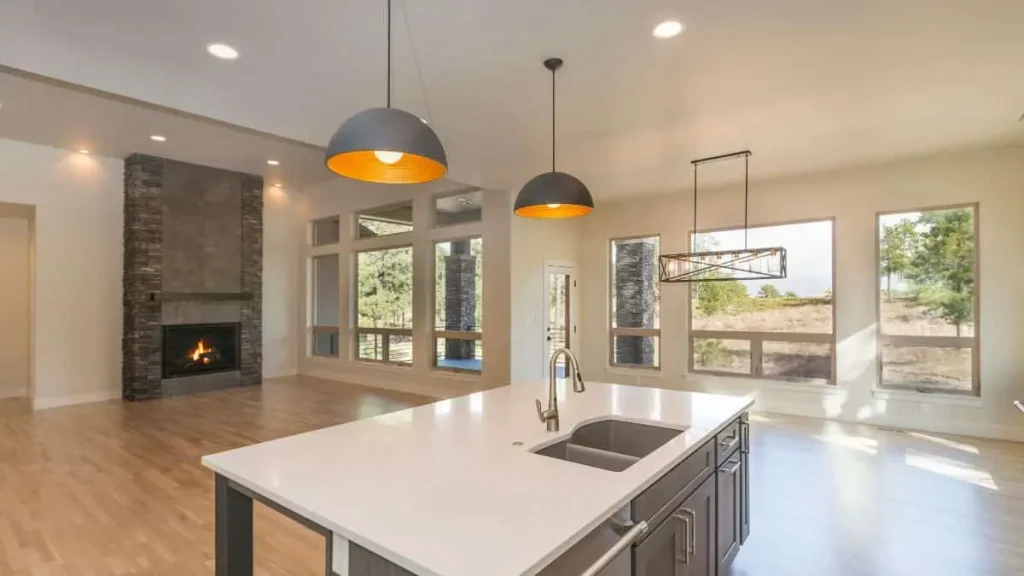
Natural Light Utilization
Maximizing natural light through large windows, skylights, and glass doors can enhance the kitchen’s ambiance, making it feel more open and airy.
Artificial Lighting Techniques
Layered lighting, including task lighting, ambient lighting, and accent lighting, ensures that the kitchen is well-lit for various activities while adding depth and warmth.
Accent Lighting for Ambiance
Accent lighting, such as pendant lights over an island or under-cabinet lighting, can create focal points and enhance the kitchen’s overall aesthetic.
Storage Solutions
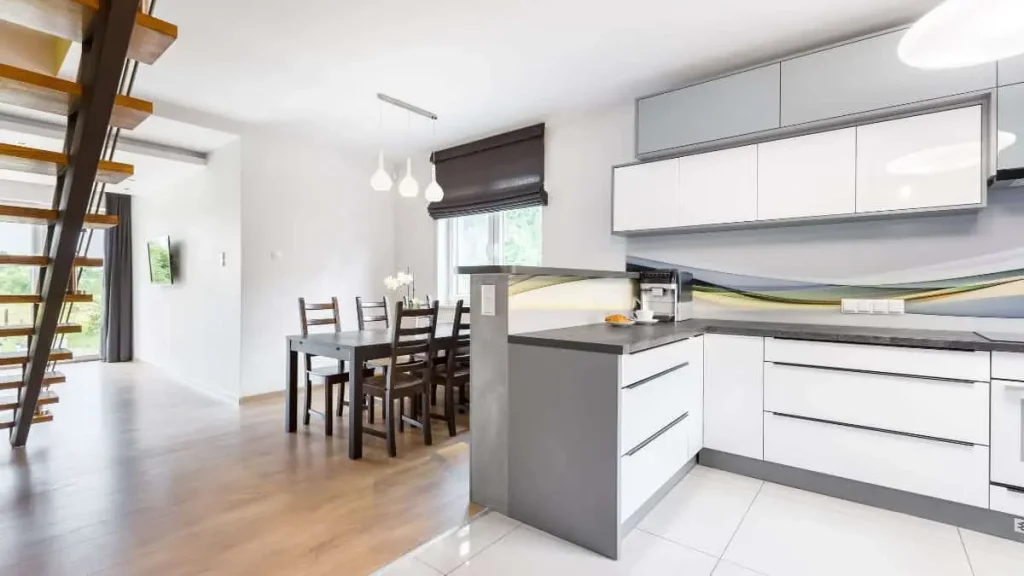
Cabinet Designs
Innovative cabinet designs, such as pull-out shelves, lazy Susans, and deep drawers, maximize storage efficiency and accessibility.
Open Shelving
Open shelving provides easy access to frequently used items and allows for decorative displays, adding a personal touch to the kitchen.
Innovative Storage Ideas
Utilizing vertical space, installing hooks for utensils, and incorporating built-in storage solutions can optimize the kitchen’s functionality.
Appliances and Technology
Smart Kitchen Appliances
Smart appliances, such as refrigerators with touchscreens and voice-activated ovens, offer convenience and efficiency, making daily tasks easier.
Energy-Efficient Options
Energy-efficient appliances not only reduce utility bills but also contribute to a more sustainable kitchen design.
Integrating Technology Seamlessly
Ensuring that technological elements are seamlessly integrated into the kitchen design maintains a clean and uncluttered look.
Flooring Choices
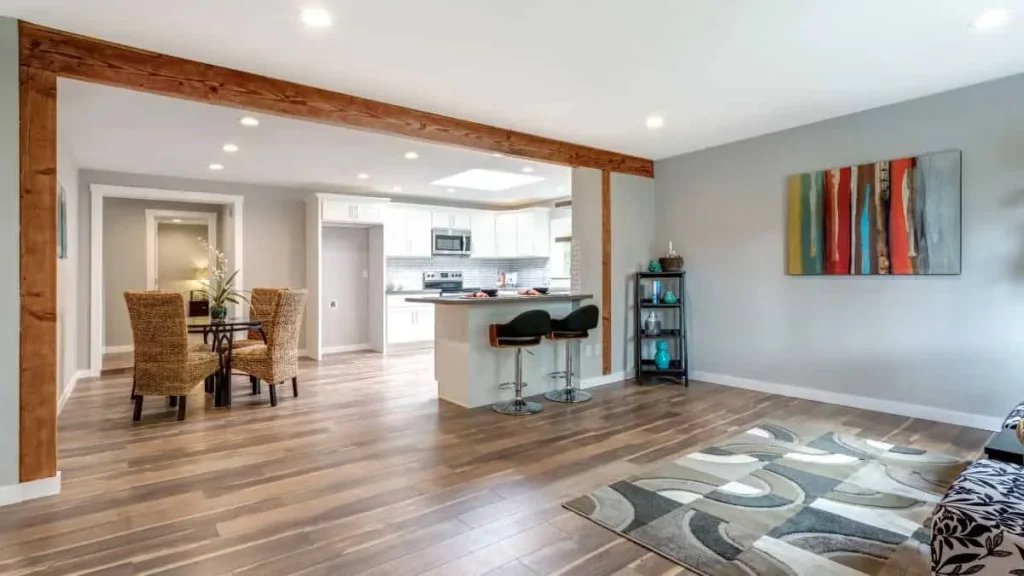
Hardwood
Hardwood flooring adds warmth and elegance to the kitchen, with various finishes available to suit different styles.
Tile
Tiles, including ceramic, porcelain, and stone, offer durability and easy maintenance, ideal for high-traffic areas.
Alternative Flooring Options
Options like cork, bamboo, and vinyl provide unique textures and eco-friendly alternatives to traditional flooring materials.
Countertops and Surfaces
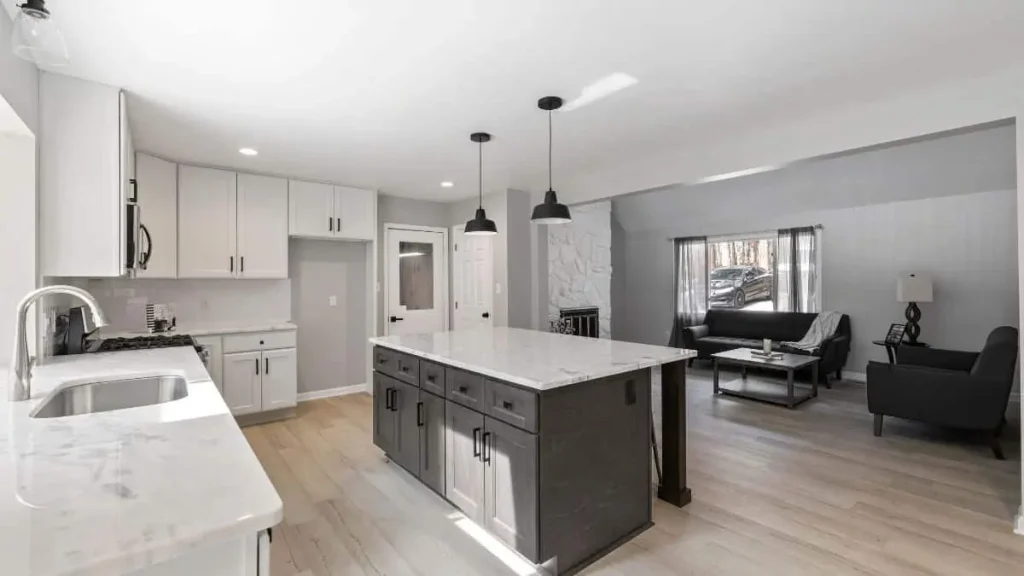
Granite and Marble
Granite and marble countertops are popular for their natural beauty and durability, available in various colors and patterns.
Quartz and Solid Surfaces
Quartz countertops offer a non-porous, low-maintenance option with a wide range of design possibilities.
Sustainable Countertop Materials
Materials like recycled glass, concrete, and reclaimed wood provide eco-friendly choices for environmentally conscious homeowners.
Backsplashes
Tile Backsplashes
Tile backsplashes, available in numerous styles and patterns, protect walls from spills while adding visual interest to the kitchen.
Glass and Metal Options
Glass and metal backsplashes create a sleek, modern look, with reflective surfaces enhancing light and space.
Creative Backsplash Ideas
Using unique materials, such as reclaimed wood or patterned tiles, can add a distinctive touch to the kitchen’s design.
Seating Arrangements
Bar Stools and Counter Seating
Bar stools and counter seating offer casual dining options and create a social atmosphere within the kitchen.
Dining Area Integration
Integrating a dining area within the kitchen space promotes family meals and gatherings, enhancing the kitchen’s multifunctionality.
Flexible Seating Solutions
Flexible seating, such as movable benches and extendable tables, allows for adaptable dining arrangements to suit different occasions.
Personalization and Decor
Incorporating Personal Style
Adding personal touches, such as family photos, artwork, and unique decor items, makes the kitchen feel more inviting and personalized.
Decorative Elements
Decorative elements, such as vases, plants, and stylish containers, can enhance the kitchen’s aesthetic without cluttering the space.
Seasonal and Thematic Decor
Seasonal decor, such as holiday decorations and themed accessories, can add a festive touch to the kitchen, keeping it fresh and lively.
Challenges and Solutions
Managing Noise and Smells
Installing effective ventilation systems, such as range hoods and exhaust fans, helps manage cooking smells and reduce noise in open concept kitchens.
Ensuring Adequate Ventilation
Proper ventilation is essential to maintain air quality and comfort, especially in open layouts where smells can travel easily.
Maintaining Privacy and Order
Using design elements like partial walls, screens, or strategically placed furniture can create a sense of privacy and order within the open space.
Future Trends
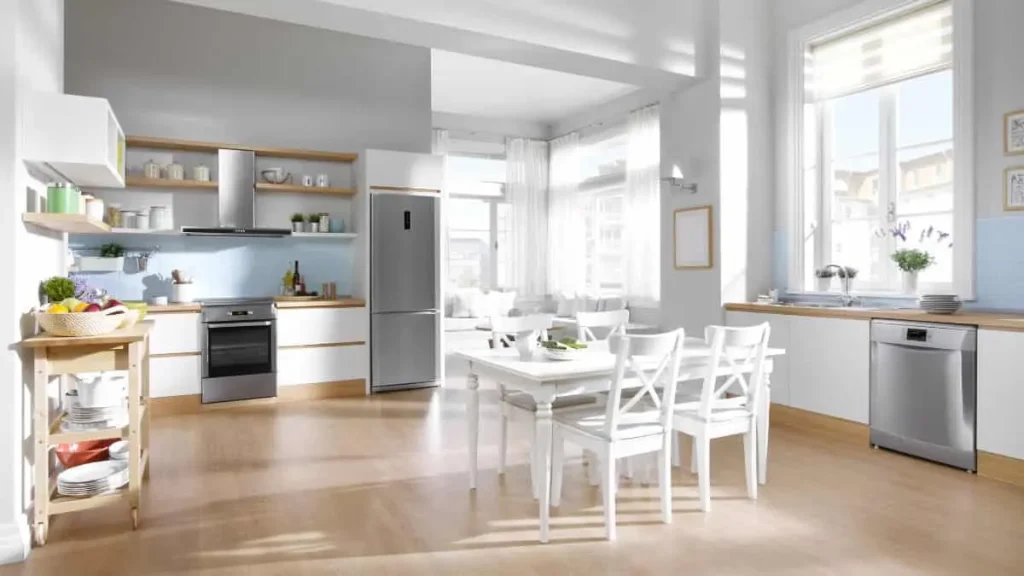
Minimalist Designs
Minimalist designs, characterized by clean lines, simple color schemes, and uncluttered spaces, are becoming increasingly popular in kitchen design.
Eco-Friendly Kitchens
Sustainable materials, energy-efficient appliances, and waste-reducing practices are key trends driving the future of eco-friendly kitchens.
Technological Advancements
The integration of advanced technologies, such as smart home systems and automated appliances, is set to revolutionize kitchen design, offering greater convenience and efficiency.
Expert Opinions
Insights from Interior Designers
Interior designers emphasize the importance of balancing aesthetics and functionality, ensuring that open concept kitchens are both beautiful and practical.
Advice from Architects
Architects highlight the need for thoughtful space planning and structural considerations to create cohesive and efficient open layouts.
Tips from Homeowners
Homeowners who have embraced open concept kitchens share their experiences, offering practical tips and advice on making the most of the design.
Resources for Learning
Books on Kitchen Design
Books such as “The Kitchen Bible” and “Kitchen Design Solutions” provide comprehensive guides and inspiration for designing open concept kitchens.
Online Courses and Tutorials
Online platforms like Udemy and Coursera offer courses on kitchen design, covering various aspects from layout planning to decor.
Design Magazines and Websites
Magazines like “Better Homes & Gardens” and websites like Houzz provide valuable insights, trends, and ideas for open concept kitchen design.
Conclusion
Recap of Key Points
Open concept kitchens offer numerous benefits, from enhanced social interaction and improved light flow to increased home value. Effective space planning, thoughtful design elements, and the integration of modern technology are crucial for creating a functional and beautiful kitchen.
Encouragement to Explore Open Concept Kitchens
With endless possibilities for customization and personalization, open concept kitchens provide a versatile and appealing option for homeowners looking to update their living spaces.
Final Thoughts on the Future of Kitchen Design
As trends continue to evolve, the future of kitchen design will likely see a greater emphasis on sustainability, technological integration, and minimalist aesthetics, ensuring that open concept kitchens remain at the forefront of modern home design.


